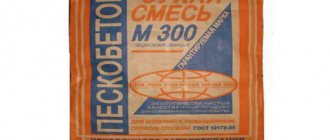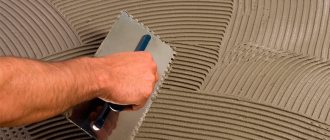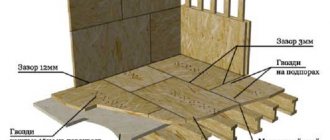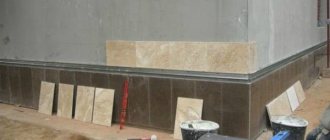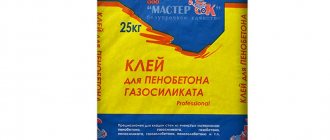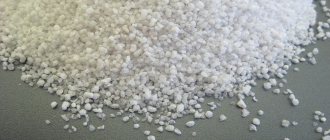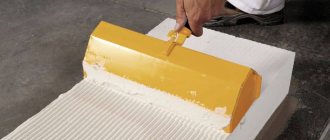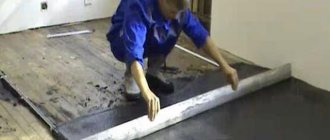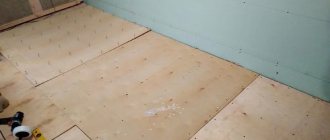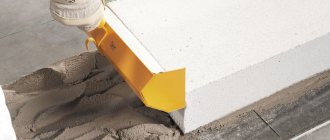How to improve the quality of cement
During the times of the Soviet Union, it was impossible to find tile adhesive and plaster mixtures, and, nevertheless, some people still have tiles in their kitchens. Today there are various “Ceresites” and superplasticizers that can increase the strength and water-repellent properties of building mixtures. Back then, all this did not exist.
So what tricks did our grandfathers resort to to improve the quality of cement? What did they add to it?
Composition of tile adhesive to make yourself
Sasha asked a question:
I decided to lay the tiles in the kitchen myself, but I don’t want to spend extra money. At home there is a bag of cement left over from filling a hole in the garage. Please tell me how to make tile adhesive with your own hands so that it is no worse than the adhesive mixture from the store.
Tiler's answer:
Anyone who has planned a home renovation is trying to save on building materials and prepare an adhesive mixture for tiles with their own hands. I will tell you a recipe that I myself have repeatedly used for laying tiles.
In order to prepare tile adhesive you will need: a mixing container, a construction mixer, cement grades M-400 or M-500, sand, and plasticizers. I use PVA glue as plasticizers, but you can also use CMC wallpaper glue, washing powder, liquid soap or detergent.
What is this article about?
Recipe with the addition of PVA or CMC
Having obtained all the necessary components and tools, let's move on to the actual preparation. To do this, mix cement and sand in a ratio of 1:3 or 1:4, depending on the brand. We begin to add water to the dry cement-sand mixture in parts with constant stirring, achieving a homogeneous mass. At this stage, the most important thing is that there are no lumps left in the solution. After the cement-sand mortar is ready, PVA, previously diluted with water, is added to it (in a ratio of 2:1). Typically, the amount of glue added (diluted in water) is 5-10% of the volume of cement-sand mortar. It is better to add glue in equal portions, remembering to mix. Preparation of the adhesive mixture ends after the required working viscosity has been achieved.
And now I will tell you how to make an adhesive mixture using CMC glue. Since wallpaper glue is sold in the form of a dry powder, before adding it to the cement-sand mortar, it must be prepared using the recommendations indicated on the product packaging. The dissolved and swollen wallpaper glue is added to the cement mortar in small portions of 200 ml. After adding CMC, the mixture is thoroughly mixed until a working viscosity is obtained.
Recipe with added detergent, liquid soap or washing powder
You can also prepare tile adhesive by adding liquid soap, washing powder or dish detergent to the cement mortar. These additives allow you to increase the fluidity of tile adhesive and, most importantly, do not change the quantitative water content.
As an example, I’ll give you my recipe for making tile adhesive with the addition of detergent. First, prepare a cement-sand mortar. It should be done in the same proportions that I indicated above. Add detergent to the finished solution at the rate of 50-100g (or 1-2 tablespoons) per bucket of cement. Mix the solution until a homogeneous mass is obtained and the glue is ready. It is not recommended to increase the amount of detergent, as this will lead to the formation of efflorescence after hardening.
Supplements
When making an adhesive solution for tiles, in addition to (or instead of) PVA, CMC and detergents, you can add special additives such as: MasterTherm, superplasticizer - C3, liquid glass, dibutyl phthalate, resin additive DEG1, superplasticizer D5, etc.
They will give the glue such unique properties as: frost resistance, heat resistance, moisture resistance, resistance to chemicals, plasticity, increased adhesion, etc. The method of using these additives will be described in the instructions supplied by the manufacturer.
And finally. To understand whether the adhesive composition prepared by yourself is ready for use, it must be applied to the tile, and if the tile moves freely along the floor in any direction, then the adhesive can be considered ready.
Additional Tips
- In order to understand whether there is a sufficient amount of water in the solution, you can use the following method. Using a trowel, scoop up the solution and tilt it; if the mixture slides off in one piece, this indicates that there is not enough water in the solution.
- After the first kneading, you should check the resulting solution using a trowel. If the mixture drains, you need to wait until the solution is infused. And also use less water the next time you knead.
- A good solution should have a uniform consistency and adhere to the surface of the trowel. In this case, you can be sure that the ceramic tiles you lay will be reliably adhered to the surface.
ATTENTION! It is necessary to check the amount of water and add it before the solution is left to sit. Once it has settled, you can no longer add water. In addition, if during the work the solution begins to thicken and lumps begin to appear in it, in this case you should not add water either. You can try stirring it again, but without adding liquid.
What you need to know about how to glue tiles to drywall
Drywall is used in many finishing works, including when laying ceramic tiles in rooms with high humidity. Before gluing the tiles, you need to level the surface. Drywall sheets are used for this purpose. But before gluing tiles to drywall in the bathroom, you will have to carry out a number of preparatory work.
Where to begin?
First of all, it is important to choose the right drywall for tiles. A material marked GVLV is suitable for this (that is, the finishing material is treated with hydrophobic impregnation).
Then the adhesive composition is selected. To do this correctly, read what is written on the packaging of this composition. The adhesive manufacturer indicates on the packaging box for which rooms and surfaces the substance is intended.
The purchased adhesive contains cement so that the tile adheres well to the paper base.
To prepare a mixture of the correct consistency, you need to mix the ingredients according to the instructions on the package.
Dilute the minimum amount of glue. Usually make a batch per 1 square meter.
To make the glue without lumps, use a construction mixer. It is important that the solution is homogeneous. After the glue is ready, leave it for a quarter of an hour - during this time the air will come to the surface.
Preparing the base of GVLV
Before gluing ceramic tiles, prepare the surface:
- After installing the drywall sheets, small gaps are observed between the sheets - they are sealed, the caps of the fastening elements (screws) are covered.
- The base is primed in two layers.
- Next, a mesh is pulled over the monolithic surface (reinforcement is provided). It is attached using PVA glue.
Laying on a prepared surface
What else needs to be done?
They start by calculating the tiles. Calculate the required amount of tiles for one row horizontally. To make the calculation, the total length of the wall is divided by the width of one ceramic tile. In this case, the thickness of the seam is taken into account, which is adjusted using a cross.
Sometimes, as a result of calculation, it turns out that on one side the ceramic tiles will have to be cut. To do this, decide where it will be located. It is better to stick the cut tiles not in a visible place (in a corner or in the place where you plan to put household appliances).
Next we move on to attaching the guides. It is important to take into account the thickness of the material. The plank is attached so that a row of tiles can be laid underneath it. The horizontal line is drawn exactly according to the level.
How to make your own dry mixture
If circumstances are such that there is no possibility of purchasing a ready-made adhesive mixture, then it is quite possible to prepare it yourself. To do this, you need to have Portland cement and fine sand available; if the latter comes in lumps, then they should be broken and the sand sifted through a sieve.
In addition to these two components, to add strength to the mixture, you can add PVA or silicate glue to it. You can find out how to make PVA glue at home and how long it takes for PVA glue to dry from our reviews.
The composition of the dry mixture should be the proportion: one share of cement to five shares of sand.
- Next, you should pour water into a previously prepared and cleaned container.
- Gradually add the dry mixture to the water, stirring constantly.
- Also at this moment you can add glue to the prepared solution.
Further actions are identical to those performed when preparing a solution using factory mixtures. After the solution has turned out to be a homogeneous mass without lumps, it needs to be allowed to brew and then mixed again. After this, the resulting solution is ready for use.
Mosaic glue. Which mosaic glue to choose? Types and types of mosaic glue.
Mosaic glue. Which glue to choose?
We are often asked the question: “Which mosaic adhesive is best?” It is difficult to answer this question unequivocally. Now the market offers quite a lot of mosaic adhesives - white, gray, imported, domestic, cement, ready-made, reactive, etc.
In this publication, we will try to understand the main differences between the main types of mosaic glue, and also decide which mosaic glue to buy to solve certain problems.
Let's start with the fact that the choice of mosaic adhesive primarily depends on the type of mosaic.
- Ceramic mosaic.
Almost any cement adhesive is suitable for ceramic mosaics. When laying ceramic mosaics, the choice of adhesive largely depends on the type and type of base (absorbent or non-absorbent, simple or complex). Since ceramic mosaics have a dense, opaque structure, both white and gray tile adhesives are suitable for gluing ceramic mosaics. If you need to glue ceramic mosaics onto a stable mineral surface (cement screed or plaster, absorbent concrete, etc.), then you can use any tile adhesive. And if you need to glue ceramic mosaics onto a non-absorbent or deformable base (waterproofing, underfloor heating system or old tiles), then you need to use elastic tile adhesives, for example “Litoflex K80 Eco” , “Adesilex P9” or “Superflex K77” .
- Mosaic made of natural stone.
The choice of adhesive for natural stone mosaics primarily depends on the type of stone. Some types of natural marble may change color when exposed to water for a long time. If the stone is sensitive to moisture, then you should choose a quick-hardening cement-based tile adhesive, such as Litostone K98 , Marmor + Granit Kleber or Litostone K99 . Such glues quickly “assimilate” the mixing water, which significantly reduces the contact of the stone with the alkaline wet glue solution. Or, for stone types that are sensitive to prolonged exposure to moisture, you can use reactive tile adhesives, such as Litoelastic , Keralastic T , Elastocol or SuperFlex Eco . Such glues do not contain water at all, so contact of the stone with moisture is completely excluded.
If natural stone is not sensitive to prolonged contact with moisture, then the choice of glue, as in the case of ceramic mosaics, will be largely determined by the type of base. Almost all adhesives class C2, according to EN 12004, are suitable for laying natural stone that is not susceptible to moisture on stable mineral surfaces. And on non-moisture-absorbing substrates, as in the case of ceramic mosaics, you need to use elastic adhesives.
- Glass mosaic.
Which glue to choose for glass mosaic? Of course white! Glass mosaic, if it has a transparent or translucent structure, allows us to see the base on which it is laid. Therefore, if you glue such a mosaic onto gray tile adhesive, then a gray rough base made of glue will be visible through the mosaic. This will certainly not add to the aesthetics of your cladding. Therefore, for translucent and transparent glass mosaics, white adhesives are chosen. This can be a white cement based tile adhesive such as Litoplus K55 , H40 Tenaflex Eco , Flexbond bianco or other white flexible cementitious adhesives with high wettability properties. Including, any white polyurethane-based adhesives (Keralastic T, Litoelastic, SuperFlex Eco) and ready-made water-based tile adhesives (Drauf + Sitzt , Litoacril ) . If the glass mosaic is not transparent (for example, “Chinese” paper-based mosaic, which is often used in swimming pools), then elastic adhesive of any color, including gray, can be used to install it.
Rules for diluting glue
Now is the time to get down to specifics and consider the basic rules for diluting the most standard adhesive mixture for tiles.
Preparing the container
It is important to properly prepare the container in which the entire mixture will be mixed.
- It should be of such a size that all the water and the glue itself fit comfortably into it and there is extra space left.
- Also, the container should not contain any dust, debris or traces of previous work. It's best to buy a new one.
The reasonable price for standard containers makes it possible to purchase new copies for each procedure.
Preparing tools
Similar cleaning should be carried out with the working equipment that you will use to dilute the glue. This training also includes the purchase of personal protective equipment.
Many adhesive mixtures have unhealthy chemical reactivity and can be harmful if inhaled by a person not protected by a mask or special respirator. It's worth taking care of this.
Proportions
There is no need to neglect proportions. Yes, there is a type of glue that does not require meticulous compliance with all norms and regulations, but this does not apply to all instances. The packaging of all modern adhesive mixtures indicates the required proportions of water and working material.
Even if you add additional components, their dosage must also strictly comply with the nomenclature.

